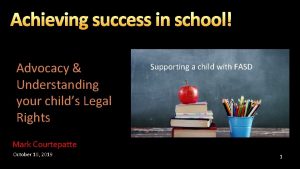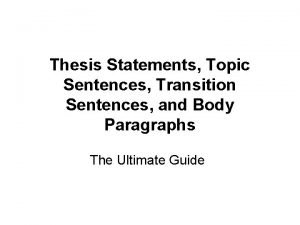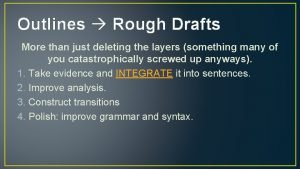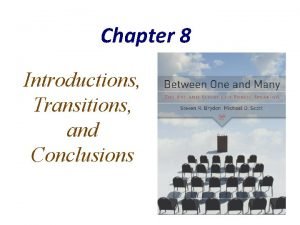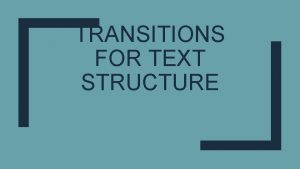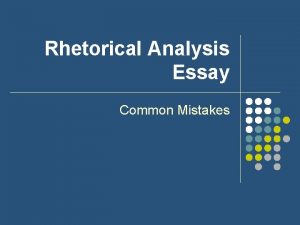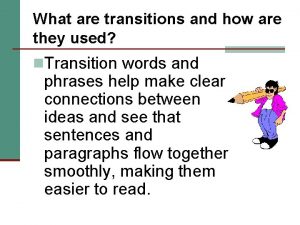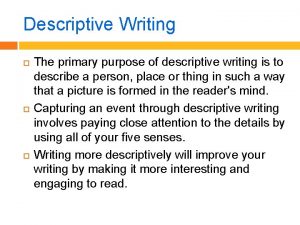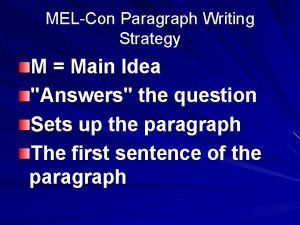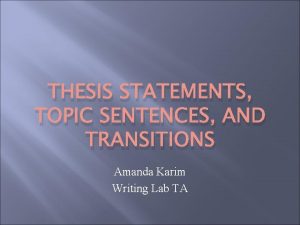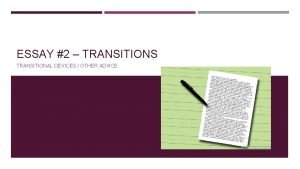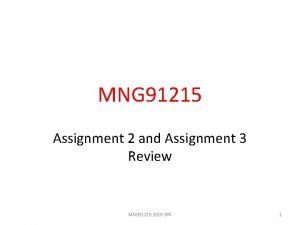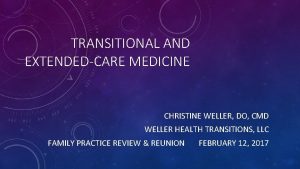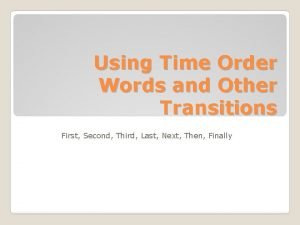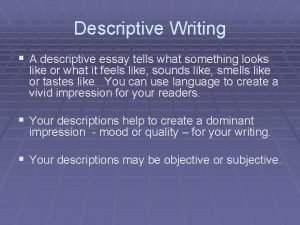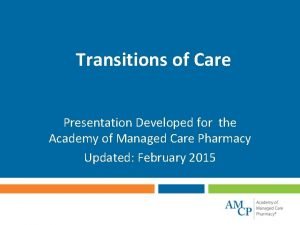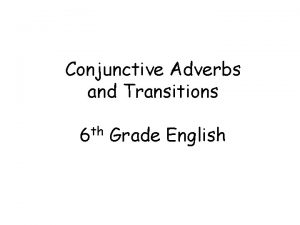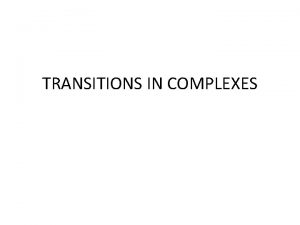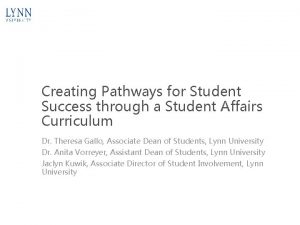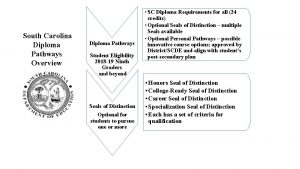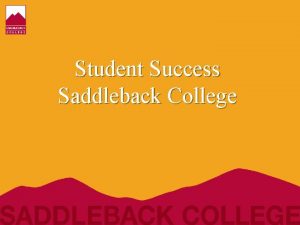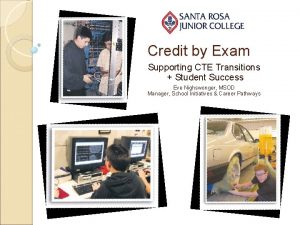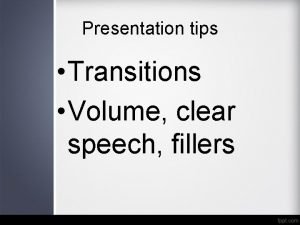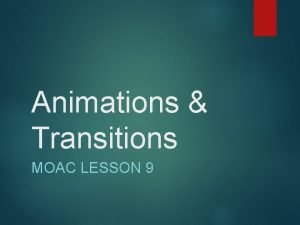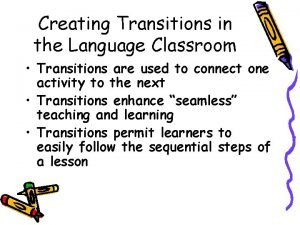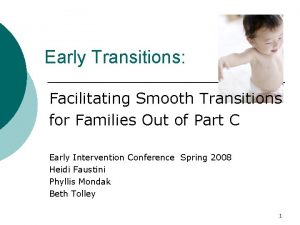Symposium on Transitions Success Pathways to Student Success























- Slides: 23

Symposium on Transitions Success Pathways to Student Success

Overview of CTE Transitions • Why pathways? • Facilitating pathways • Programs of Study • CTE transitions activities • Student articulation processes and credit by exam • C-ID and CTE

Why pathways? • It’s the right thing to do – for students, for the state, for employers. • Significant investments have been made in facilitating the establishment of such pathways – it is critical that they meet their potential. • Perkins funding…

Perkins Language • Local Education Agency (LEA) … must provide at least one program of study that incorporates secondary and postsecondary elements; includes coherent and rigorous content aligned with challenging academic standards and relevant CTE in a coordinated, non-duplicative progression of courses that align secondary education with postsecondary education to adequately prepare students to succeed in postsecondary education; and leads to an industry -recognized credential or certificate at the postsecondary level, or an associate or baccalaureate degree.

Facilitating Establishment of Pathways • Keys to development AND effectiveness? • Simplicity. − Clear messaging. − Simple process. • Portability. − HS > CCC − Between CCCs • Productivity.

Statewide Career Pathways (SCP) • Project of the Academic Senate for California Community Colleges • SB 70 (2005) Education Code § 88532. • Improving linkages and CTE pathways between HS and CCC

Statewide Career Pathways (SCP) • SB 1070 (2012), Education Code § 88532. • Established the CTE Pathways Program • Develop and strengthen linkages and CTE pathways between HS and CCC to accomplish specified objectives • Included separate marketing campaign − whodouwant 2 b. com

Statewide Programs of Study • Program of Study (Po. S) Templates − SCP convenes faculty to develop templates − Po. S templates facilitate relationship discussion − Articulation and dual enrollment are part of Po. S discussion • Local Programs of Study are developed as a result of a local relationship between institutions


Programs of Study include • High School Courses • College Coursework: C-ID Course numbers • College Activities • Occupations specific to discipline • Certifications, Degrees, Outcomes • CTE transition activities: − Dual Enrollment − Concurrent Enrollment − Articulation

Programs of Study include • CTE transition activities: − Dual Enrollment − Concurrent Enrollment − Articulation

Dual Enrollment • High School students taking college courses on the high school campus for credit with both institutions. • Can be complicated to initiate • Detailed policy and protocols required

Concurrent Enrollment • High school students taking college courses for college credit. • No MOU is in place, typically • High schools may allow credit

Articulation Basics • What is articulation? • Why articulation versus other K 12 >>> CCC transition pathways? • What does articulation do and not do? − Local requirements versus credit granting • How is articulation created and implemented − Agreements and processes

Agreement Templates • Articulation Templates − SCP convenes faculty to develop templates − Articulation templates facilitate articulation discussion − Local agreements also housed in online repository • Local agreements are generated based on approved templates between a secondary school and a post-secondary institution, usually a community college

Articulation Agreements • Similar components to a course outline of record: − − − − Course description Prerequisite Course Content Competencies and Skills requirements Measurement Methods Sample Textbook End of Course assessment detail is key piece

Articulation VS Credit By Exam (CBE) • Articulation − Only waives local requirements – pre/corequisites, placement, etc. − Does not earn college credit – but can be the basis for allowing credit by exam (CBE)

Articulation VS Credit By Exam (CBE) • Credit By Exam (CBE) − Students complete proficiency/mastery exam for college credit. − Evaluation must be developed by appropriate faculty − Evaluation may be proctored • Process and procedures must be clear • White Paper on best practices available: http: //asccc. org/publications/academic-senatepapers

Credit by Exam – Issues and Challenges • Students not getting credit. • Why not? • Potential fixes?

C-ID and CTE • C-ID − Course Identification Numbering System − Descriptors describe courses • Transfer Model Curricula in CTE − “TMC” − 60 + 60 – response to SB 1440 • Model Curricula − Certificates − “Terminal” degrees

Questions to Consider Today • What are the best practices from today that can most impact our students in the HS CC pipeline? • What are practices currently in place that are counter to student success that may need adjustment? • What are the barriers to creating a best practice policy/protocol on my campus? How can those issues be resolved?

Questions • Thank you • http: //www. statewidepathways. org • http: //whodouwant 2 b. com/student/pathways • http: //www. asccc. org/ − For papers and this presentation

Michelle L. Pilati, Ph. D. Faculty Coordinator, C-ID (www. c-id. net) Immediate Past President, Academic Senate for California Community Colleges Professor of Psychology, Rio Hondo College mpilati@riohondo. edu Kris Costa Articulation Liaison, Statewide Pathways Project Academic Senate for California Community Colleges kris@asccc. org
 Your child's success or lack of success
Your child's success or lack of success Your child's success or lack of success
Your child's success or lack of success Paragraph transition examples
Paragraph transition examples Tlq transitions
Tlq transitions Logical transitions
Logical transitions Transitions for conclusions
Transitions for conclusions Whats transition words
Whats transition words Transitions for rhetorical analysis
Transitions for rhetorical analysis Electronic transitions
Electronic transitions Transition words for sequence
Transition words for sequence Gregory is my beautiful gray persian cat
Gregory is my beautiful gray persian cat Melcon transitions
Melcon transitions Thesis and topic sentence
Thesis and topic sentence Transitional devices
Transitional devices William bridges transitions model
William bridges transitions model Finite automata with epsilon transitions
Finite automata with epsilon transitions Christine weller
Christine weller Melcon transitions
Melcon transitions Rame tep meaning
Rame tep meaning Time order transitions
Time order transitions Live windows movie maker
Live windows movie maker Transitions for descriptive essays
Transitions for descriptive essays National transitions of care coalition
National transitions of care coalition Conjunctive adverb
Conjunctive adverb
